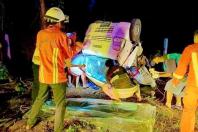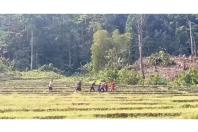
Minneriya is known to be the world’s largest gathering place of the Asian elephant. This is an annual event occurring around the month of August. Wildlife enthusiasts, elephant behaviour scientists, researchers, scholars, animal and nature lovers commonly flock to Minneriya at that time to see what is among the greatest shows of the animal world on earth.
The fierce sun and the dry pre-monsoon winds reduce the water holes in the jungle to next to nothing during the dry season. The majestic elephant and many other animals are drawn at this time of the year to what water is left in the Minneriya tank and to feed on the newly grown grass on the dry peripheral tank bed. This year too nature lovers and wildlife enthusiasts, together with the animal behavior scientists, gathered to view the annual spectacle. But there was no show this time as the elephants did not gather as usual. Why?
Ancient background
Chandana Sooriyabandara, Director General, Department of Wildlife Conservation, says that the area hosts some of the country’s best National Parks, Minneriya and Kaudulla among others. They are part of an ancient irrigation system. Nihal Siriwardana, Additional Director General of Irrigation, says the area is within the System G of the Mahaweli Scheme. Moragahakanda reservoir feeds the tanks of Minneriya, Giritale, Elahera Canal, Kaudulla, Kantale and Parakrama Samudraya.
Seasonal abodes
Hence the area provides three seasonal habitation areas for hundreds of elephants. According to many Wildlife Department staff at these national parks, the elephants are at Minneriya from April to October, Kaudulla from October to December and the Hurulu Eco Park from December to April.
Dr. Sumith Pilapitiya, a former Director General of the Department of Wildlife Conservation, who was Lead Environmental Specialist, South Asia Region of the World Bank, says that the elephants who generally move to Kaudulla with the monsoons in October moved in July this year.
Elephants feed on the grassland on the outer perimeter of the tank during the dry season. During the drought water remains only in the middle of the tank. This makes the rest of the tank bed hospitable for grassland. Over the centuries, these have been the traditional feeding grounds of the elephants.
Drs. Pilapitiya and Prithiviraj Fernando speculate that when the Minneriya tank started filling this year, the elephants may have got disturbed. According to elephant behavior researchers, such disturbance may occur due to more than one reason. In general, the animals would not be comfortable with the rising water level at the ‘wrong’ time of the year during the dry season. Fearing the threat of flooding, they would instinctively move for safety and survival.
Agricultural seasons
Humans have their sowing and harvesting seasons, as much as animals have their feeding seasons. They have co-existed for centuries, one supporting the other. The yala season is from end March to August and maha from end October to April with fields lying fallow from August to October.
Farmers prepare their chenas during the dry weather with the late October monsoon rains helping their crops. But there was a severe drought during yala this year compelling the Irrigation Department to fill depleted tanks with water from the Moragahakanda reservoir.
Preparing the chenas is done by the farmers during the drought. The late October monsoon rain would then greet the freshly planted seeds. What happened this year?
Diversion of water
From Moragahakanda, water is directed to Diyabeduma and from there, the left bank canal takes water to Minneriya, and the right bank canal to Giritale. Minneriya feeds Kantale and Kaudulla via the Yoda Ela.
Irrigation vs. Wildlife
Minneriya tank which feeds Kantale and Kaudulla has a total capacity of 110,000 acre feet when full. If water is to be issued to Kaudulla, Minneriya has to hold at least up to 60,000 acre feet as the lowest spill at Agalawana is at 55,000. Kantale tank would be fed from the MKYE (Minneriya Kantale Yoda Ela) spill. For that purpose the tank has to be at 70 000 acre feet, according to the records of the irrigation engineers.
Irrigation Department sources affirmed that the struggle is to provide the hard working farmer with sufficient water for cultivation. Unless water if not plentiful, or at least adequate, the fruits of the farmers’ labour cannot be reaped.
The interest of the elephant is certainly important. They were the original inhabitants of the land with humans being encroachers. It was necessary to clear forests and settle farmers in the dry zone to grow sufficient food for an ever expanding population.
This is a story with two equally sensitive sides; that of the farmers and the other of the animals. Sustenance of agriculture is pivotal. On the other hand, the island is increasingly dependent on tourism and the Wildlife Park are major props of a growing tourist industry with Minneriya only second to Yala.
Moving forward
All these issues need to be carefully balanced when structuring/re-structuring national policy. Who is more important - the farmer or the elephant? This is a long debated issue where humans have taken precedence.
The big picture is inter-connected as climate concerns worldwide have amply demonstrated. But we must all appreciate that Mother Nature has no favourites and a fine balance must be achieved. This will be with costs for both sides of the equation.









